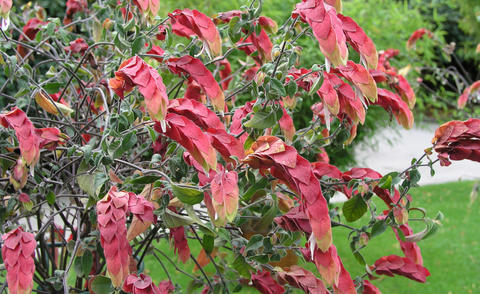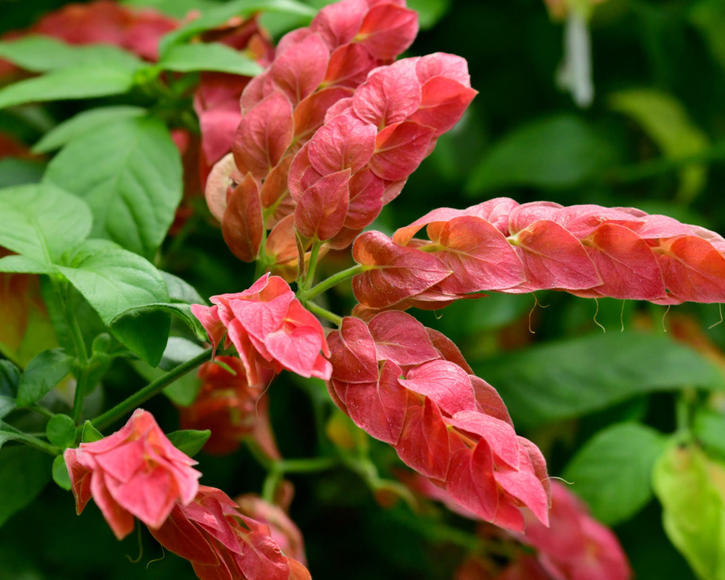Shrimp plant
The shrimp plant captivates all year round with vibrant, long inflorescences. It is also an uncomplicated housemate - provided you enjoy watering.
Factsheet
- Growth type
-
- half shrub
- Growth height (from)
- from 60 cm to 100 cm
- Growth characteristics
-
- overhanging
- Flower color
-
- yellow
- red
- white
- Flowering time (month)
-
- March to October
- Flower shape
-
- ear-like
- Leaf color
-
- green
- page format
-
- ovate
- Sheet properties
-
- evergreen
- Fruit shape
-
- Capsule
- Light
-
- sunny to scattered light
- Soil type
-
- sandy to loamy
- Soil Moisture
-
- fresh to humid
- ph value
-
- neutral to weakly acidic
- Lime compatibility
-
- sensitive to lime
- Nutrient requirements
-
- moderately nutritious
- Humus
-
- rich in humus
- Decorative or utility value
-
- Flower Decoration
- Winter Hardness
-
- frost-sensitive
- Use
-
- Interior greening
- Planters
- Winter garden
- Warm House
- Garden style
-
- Pot garden
The shrimp plant (Justicia brandegeana) from the Acanthaceae family originates from Mexico.
The shrimp plant develops into a 23.62 to 39.37 inch tall semi-shrub, depending on the pot size. Its appearance is characterized by soft, overhanging shoots and velvety leaves.
The fine haired, evergreen leaves are ovate and 1.97 to 2.76 inches long. They are positioned on opposite sides of the shoot.
The shrimp plant has the up to 3.94 inch long inflorescences that are reminiscent of shrimps, and which it has to thank for its name. The spikes are made up of inconspicuous white flowers that are surrounded by extremely pretty, coral red and yellow bracts. While the white flowers drop quickly, the bracts last for several months. The inflorescences are put out all year round, with the exception of during the rest period in the winter.
The shrimp plant forms capsule fruits in its natural environment; these are rarely seen in indoor cultivation.
The brighter the environment for shrimp plants, the more compact they grow and the more intensively vibrant the color of their bracts. It does not tolerate direct, glaring midday sun. It enjoys being in the fresh air from May to October. As a tropical plant, Justicia deals very well with our room temperatures. It should only be placed somewhere a little cooler in winter: 59 to 64.4 degrees Fahrenheit is ideal.

A slightly acidic mixture of garden soil, clay, and compost will best meet the requirements of the shrimp plant. However, it also grows well in normal houseplant potting soil.
Shrimp plants need a lot of water. So you will need to water it regularly. The ball may not be allowed to dry out, however it should also not be continuously wet. Because its roots cannot tolerate waterlogging. It’s good to let Justicia’s substrate remain dry for a few days between watering during the rest phase between November and February. The shrimp plant does not tolerate cold, calciferous tap water. It’s best to water it using rain water.
The Shrimp plant should be fertilized every two weeks in the spring and summer. Ideally, you should add liquid fertilizer to the water for houseplants. Alternatively, you can provide the nutrient supply using fertilizing rods, which you insert into the potting soil. As soon as the days start getting shorter at the start of fall, you should stop fertilizing Justicia until the spring.

If you see that your Shrimp plant is outgrowing its home, or that its roots are jumping out of the pot, its best to pot it in a new container with a larger diameter in the spring. It is worthwhile pruning the shoots of the Justicia before moving it. You can also readily prune its roots - in particular if you see that they have suffered. As the roots rot quickly, it is important to equip the pot base with a permeable drainage layer of gravel or expanding clay.
It is in the genes of shrimp plants to grow in every direction. It only retains a compact shape if it is pruned back annually in the spring. Here, its shoots may be pruned back to at least half the length. You can also cap the shoot tips from time to time in the summer, until around August.
Justicia is easy to propagate. Offspring can be obtained vegetatively from cuttings. It’s best to cut off long shoots, 3.15 to 3.94 inches long from long shoots obtained during pruning in the spring. The lower leaf pairs of the cuttings should be removed before they are inserted in groups into a pot filled with an earth-sand mixture or potting soil. A plastic hood or a clear plastic bag placed over the offspring helps to prevent the soil from drying out too quickly. It takes about six to eight weeks for the cuttings to form roots. As soon as the young plants begin to grow, they can be moved into normal flower soil. They should be regularly pruned for compact growth.
If the colorful bracts of the shrimp plant lose their vibrancy, then its location is too dark. If Justicia loses its leaves in the winter then its location is too warm. It is also susceptible to white fly, and sometimes it can be infested by aphids and spider mites.

